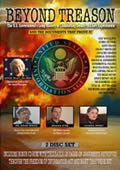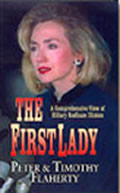AMENDING
THE CONSTITUTION BY ERASER
PART 2 of 3
By
Jon Christian Ryter
November 21, 2008
NewsWithViews.com
When the Susan B. Anthony Amendment (the 19th Amendment) was offered to the 67th Congress, language to degenderize Article II was added in the Senate version, but was almost immediately stripped from the resolution because moderates in both the House and Senate knew the measure, offered several times since 1868, would never pass with that language in it. The 2003 Equal Opportunity to Govern Amendment, which was touted as an amendment to repeal the "natural born citizen," clause also degenderized the office of the presidency. The amendment, referred to the "Schwarzenegger Amendment" was actually the "Hillary Clinton Amendment." Schwarzenegger publicly asked that his name not be associated with the debate. The amendment failed. Yet, Hillary Clinton entered the presidential race of 2008 as the Democratic front-runner, and Gov. Sarah Palin [R-AK] became the Republican vice presidential running mate. Again, the magic eraser was applied to erase the gender from Article II. Ask anyone you bump into on the street if they believe a woman can legally seek the office of President. Without batting an eye, 97% of those you ask will say "yes." By practice, the "magic eraser" degenderized Article II—without the need to ratify an amendment that failed to clear the hurdles in Congress everytime it was attempted.
While the Constitution of the United States gave Congress the prerogative to change the day (singular) when votes are cast for the President of the United States, it designated the first Tuesday after the first Monday in November every four years as the day when votes shall be cast. Specifically, the Constitution mandates that the "...day shall be the same throughout the United States." In other words, while it is convenient for civil rights activists to push for State laws that allow early voting where people who are not legally eligible to vote can vote with minimum scrutiny from election officials, the Constitution trumps State law—or local party politics.
Constitutionally, votes are to be cast for the President of the United States on only one day every four years. While Congress has the right to change the date when votes for the President are cast, it does not have the right—without the ratification of a constitutional amendment—to expand that one day into many. Nevertheless, the politically-correct "magic eraser" was used to add from one to two weeks to "election day" by arguing that some people might lose their right to vote if they have to wait in line and cast their ballot on constitutional election day. When that tenet was added to the Constitution, the voters were spread all over the countryside. None of them had cars to speed to the voting precinct to cast theri vote on election day. They traveled by cart, wagon, horseback or mule to vote. And, by the time the polls closed on election day, everyone who was eligble to vote and everyone who wanted to vote, voted.
Expressing empathy that the masses may not be reaching the polls in time to have their votes counted, it seems not to have dawned on the bureaucrats to simply add more polling places on election day. However, making sure that eligible voters were able to vote that was not the real reason for the early voting.
Applying the "magic eraser" to the Bill of Rights is not a new trait. It actually began on July 14, 1798. On that date, President John Adams signed the Sedition Act of 1798 into law making it a crime to criticize the President of the United States, thereby outlawing free speech in the United States only ten and a half years after the ratification of the Constitution of the United States. In 1801 the States repudiated the Sedition Act of 1798 with the Kentucky and Virginia Resolves, taking the federal government to task for violating the Bill of Rights and reminding the federal government that the States held the power to nullify any law written by Congress if it exceeded its narrow authority under the Constitution.
The next major assault on the Bill of Rights occurred on March 9, 1933 when Congress began the practice of voting on legislation that [a] was not written by Congress nor [b] read by them before being enacted into law. On March 9, within 12 hours of its introduction to Congress, the Emergency Banking Relief Act of 1933 was signed into law by President Roosevelt.
After
40 minutes of debate from both sides of the aisle, Congress enacted
the Emergency Banking Relief Act of 1933, a bill they never
read, which gave the Treasury the right to confiscate all gold possessed
by US citizens and replace their gold certificates and gold coins with
a fiat scrip that had no inherent value. Without a constitutional amendment
to remove the nation from the gold standard, the Roosevelt Administration
used the "magic eraser" to surrender the nation's monetary
system to private bankers. Before his administration ended with his
death on April 12, 1945, Roosevelt at least partially erased the entire
Bill of Rights. Among those rights he fully intended to completely erase
was the 2nd Amendment.
FDR became the target of a attempted assassination on February 15, 1933
while giving a speech to a crowd of about 2,500 well-wishers at Miami,
Florida's Bayfront Park. The would-be assassin was an Italian immigrant
named Giuseppe "Joe" Zangara. Zangara blamed both outgoing
President Herbert Hoover and President-elect Roosevelt for the erosion
of the economy. As Roosevelt finished his speech and left the platform
to return to the touring car, the throng of people moved forward to
shake the hand of the President-elect. Six shots, fired in rapid succession,
scattered the well-wishers.
A woman in the crowd near the assassin, Mrs. M.J. Cross of Miami, grabbed Zangara's arm, spoiling his aim. Instead of hitting Roosevelt, Zangara's bullets found Chicago mayor Anton J. Cermak. In addition, New York police officer William Sinnott was shot over the left eye but survived. Margaret Kruis, a resident of New Jersey who was vacationing in Miami Beach was shot in the upper body. And, Mrs. Joe Gill, wife of the president of Florida Power & Light, was shot in the abdomen. Cermak who had just left the platform, was standing on the running-board of Roosevelt's touring car, between the assassin and FDR when Zangara began shooting. Cermak died on March 6 as FDR was being inaugurated as the 32nd President of the United States.
Zangara, who had already been tried and convicted for the deadly assault was swiftly retried and sentenced to death for the murder of Cermak. Five weeks after attempting to kill Roosevelt, Zangara was executed in the electric chair at the Florida State Prison in Railford. Had that crime happened today, the assassin would have spent 10 to 20 years on death row until, finally, his sentence would be commuted by either a liberal State governor or an equally liberal president.
Roosevelt pushed The National Firearms Act of 1934 through Congress. It took a year to enact the legislation because FDR expected Congress to outlaw firearms. Instead, the law imposed a sales excise tax of $200 on the initial sale of any machine gun, short-barreled rifle or sawed-off shotgun (referred to in the law as "Title 2 weapons"), or when such weapons were transported across a State line. When the law was written, the excise tax was going to be imposed on a broad range of "criminal" weapons, but Congressmen who wanted to get reelected refused to vote for it. In the end it affected only three types of weapons—but excluded handguns—that were favored by the mobsters during the bootleg era. The law was largely ceremonial, but the magic eraser was now being applied to the 2nd Amendment.
The law also created a national registry for all weapons (the same ploy German Chancellor Adolph Hitler used as the necessary first step in the confiscation of firearms in the Third Reich). Trying to figure out how to circumvent the 2nd Amendment, FDR's Attorney General Homer Cummins knew what Roosevelt wanted could not happen since they could not simply outlaw guns. However, Cummins devised the scheme to tax guns out of existence. (Keep in mind that, in 1934, the average wage per hour was about 25¢, and the average urban center factory worker earning about $15.00 for a 60 hour workweek. That average-income worker would have to work 13 1/3 weeks, using 100% of his gross wages, to pay the excise tax charged by FDR on a short-barreled rifle or sawed-off shotgun.
FDR tried again in 1938 with the Federal Firearms Act of 1938. This time around, FDR tried to clone the New York Sullivan Law (which he helped enact as a State Senator in 1911, and which he amended as New York governor in 1931 by requiring people who purchased guns in New York to be fingerprinted and photographed). FDR's second attempt to outlaw guns resulted only in the licensing of gun dealers and restricting gun sales to felons. What he had hoped for was vetting rights over who could purchase a gun, giving him the right to deny almost everyone.
The constitutional pencil eraser of 1934 became a massive gum eraser when utopian politicians allowed their special interest campaign contributors to pen the Anti-Terrorist Act of 1995 and both Patriot Acts as utopians attempted to eviscerate the Constitution of the United States so it could more easily be morphed into the UN Covenant on Human Rights under which all rights are conditioned on the whims of government and none of them are construed to be inherent.
In the Constitution, the Founding Father placed all of the restrictions on the government. Somewhere down the road to the toll bridge to Utopia, using the gum eraser of liberalism, the Bill of Rights became somewhat blurred because Congress and the federal courts now place all of the restrictions on the People. Our inherent 1st Amendment right to worship God as we please morphed into the conditional right of Europeans under the UN Covenant on Human Rights. Today, Congress now believes it can make laws respecting the establishment of religion and barring the free exercise thereof since the US Supreme Court has decided that the "...freedom to manifest one's religion or beliefs may be subject only to such limitations that are prescribed by law..." (Taken from Article 13, UN Covenant on Human Rights.)
Electing liberal politicians in the US Senate guaranteed that the magic eraser would change not just the 1st Amendment's guarantee of free speech and religious liberty, but the entire Bill of Rights. In the Anti-Terrorism Act of 1995, HR-666 (the original House version that flew through the US Senate) would have virtually suspend the Bill of Rights during "national emergencies." When the American people learned the details of HR-666, S.735 (its Senate clone) had already flown through the GOP- controlled US Senate. Under HR-666, the 2nd Amendment would have been legislatively abolished. Under the 3rd Amendment, the Posse Comitatus Act of 1878 which bars the federal government from using military troops as officers of the law, would have been repealed, amending 18 USC 1385 by allowing the President to use National Guard troops to police the streets of America.
|
Subscribe to the NewsWithViews Daily News Alerts! |
HR-666 would have also suspended due process under the 5th Amendment, and eliminated the right of the accused to face his accuser under the 6th Amendment. In addition, HR-666 would have legislatively abolished the 10th Amendment, giving the federal government supra-authority over the States with all power emanating from the White House. (S.735 was passed on an unrecorded voice vote. None of the 91 Senators who voted to erase the Bill of Rights wanted their fingerprints anywhere near this bill that could come back to haunt them when they sought reelection) For part three click below.

















